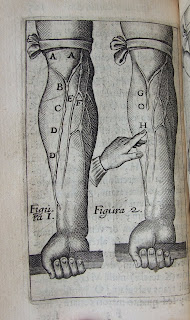William Harvey’s “On the Movement of the Heart and Blood”
This is the second in a series of posts from RCPI’s Librarian looking at key items within Dun’s Library.
 |
| Galen |
European medical knowledge and teaching in the 17th century was still dominated, as it had been for the previous 15 centuries, by the system of medicine expounded by the great Roman physician Galen, who had died in AD 200.
The Galenic system was based on the need to maintain a balance of the bodily fluids called humours, specifically blood, phlegm, yellow and black bile. The ideal was to allow these fluids to circulate freely. The lungs were seen as being responsible for moving the blood around throughout the body.
 |
| Sir William Harvey |
This belief was beginning to be questioned by a few doctors in the late 16th century but few dared to challenge the teachings of Galen until the appearance of William Harvey. Harvey was born in 1578 in Folkestone, England. He received a BA degree from Cambridge in 1597 and then studied medicine at Padua in Italy, receiving his doctorate in 1602. He practised at St. Bartholomew’s Hospital in London and was appointed Court Physician to King James I in 1618 and then to Charles I in 1640.
Harvey started investigating the role of the heart in the circulation of the blood as early as 1615 and published his findings in 1628 in his work Exercitatio anatomica de motu cordis et sanguinis in animalibus or, On the movement of the heart and blood in animals. The book caused great controversy and Harvey’s theory was not to be fully accepted for another 20 years but, eventually, his classic work became the foundation for all modern research on the heart and cardiovascular medicine.
 |
| Title Page of the 1661 edition |
 |
| Illustrations from 1661 edition |
The College Library holds several editions of Harvey’s work. The earliest is a small, duodecimo edition, published by Arnold Leers in Rotterdam in 1661. It is listed in the earliest extant catalogue of the Library, that of 1794, and may have formed part of Sir Patrick Dun’s original bequest.
William Harvey became the greatest name in English medicine through his epoch-making discovery and he is commemorated as one of the founding fathers of medicine depicted on the College mace.
Robert Mills